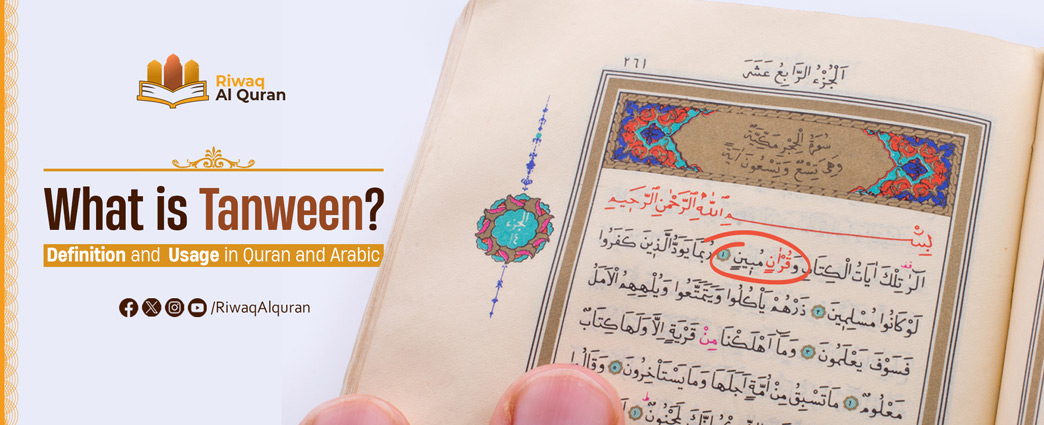Tanween (Nunation) (Arabic: تنوين) is a vital feature in the Arabic grammar and phonology. It represents the concept of indefiniteness in nouns and adjectives. It also helps to clarify a word’s syntactical role in a sentence. Tanween has some rules in the Arabic language in general. However, it has some extra rules when it comes to reciting the Quran correctly (following the rules of Tajweed).
In this article, we will explain the definition of Tanween in Arabic. Then, we will explore some of Tanween’s rules in Arabic and Tajweed. We will also explain the main types and the symbol of Tanween with some examples. Finally, we will point out the main differences between Tanween in Arabic and Tanween in Tajweed.
Table of Contents
Definition Of Tanween In Arabic
Tanween (Nunation) in Arabic refers to the grammatical phenomenon that indicates indefiniteness and a specific grammatical case (nominative, accusative, and genitive) in the sentence. When pronounced, Tanween signs add an “n” sound to the end of a word. So it plays a crucial role in the syntax and pronunciation of words, especially in Classical and Quranic Arabic.
Tanween Rules In Arabic
In Arabic, Tanween has some general rules that need to be understood and implemented. Please see below some of these rules.
1- Tanween Is Used With Indefinite Nouns Only:
A- Tanween indicates that the noun is not specific.
For example:
“اشتريت قلمًا” [I bought a pen]
“رأيت رجالاً” [I saw some men].
Both “a pen” and “some men” are not specific [definite] terms, so Tanween is implemented.
B- Tanween Cannot be used with definite nouns (those marked by the ِArabic definite article “ال”).
For example, “الكتاب” [without nunation] means “the book” (definite), while “كتابٌ” [with nunation] means “a book” (indefinite). So, “الكتاب” cannot have Tanween.
2- Tanween Is Used With Nouns And Adjectives Only:
Tanween is only used with nouns (including proper nouns in some cases) and adjectives, but not with verbs or prepositions.
For example: “قابلتُ زيدًا” [I met Zayd], and “ساعدت شيخًا كبيرًا” [I helped an old man].
“زيدًا” is a proper name, “شيخًا” is a noun, and “كبيرًا” is an adjective. All of these should have nunation as they are here in the accusative case.
3- A Special Pronunciation When Tanween Is Followed By A Pause:
When a word with Tanween is followed by a pause, the final “n” sound along with the vowel sound (a, u, or i) are dropped. This is due to the very common rule of thumb: [Arabic speakers do not start with a Sakin letter and do not end with a Mutahrik letter]. Since Tanween is Harakh, it is dropped when the reader stops at the noun/adjective with Tanween.
For example: When we say “جاء عمرٌ إلينا” [Omar came to us], the “n” sound of the nunation in “عمرٌ” is kept. However, if we say “جاء عمر” [Omar came], the “n” sound of the nunation in “عمرٌ” is dropped, because we stop at “عمر”.
4- Functions Of Tanween:
Tanween plays a crucial role in Arabic syntax and pronunciation, as it not only indicates the indefinite nature of a word but also reflects its grammatical case (nominative, accusative, or genitive). Please see below the two main functions of Tanween.
A. Indefiniteness:
Tanween signifies that the noun is not specific. For example, “يدٌ” [with nunation] means “a hand” as opposed to “اليد” [without nunation], which means “the hand”.
B. Grammatical Cases:
Tanween appears in different cases [nominative (مرفوع), accusative (منصوب), and genitive (مجرور)], depending on the word’s role in the sentence. For example, we say “رجلٌ عظيم” with a nominative nunation in “رجلٌ” as it is in the nominative case, and we say “رميت بسهمٍ” with a genitive nunation in “بسهمٍ” as it is in the genitive case.


Tanween Rules In Tajweed Of The Quran
Along with the rules of Tanween in Arabic, Tanween in Tajweed of the Quran has some extra rules. These rules help to preserve the clarity and precision in reciting the Quranic verses. Here are the key Tanween rules in Tajweed:
1- With Ikhfaa letters:
When followed by one of the Ikhfaa letters [ت – ث – ج – د – ذ – ز – س – ش – ص – ض – ط – ظ – ف – ق – ك], the noon sound of the nunation is dropped and a Ghunnah is kept for 2 Harakat. Ghunnah is a nasal sound that is produced when someone utters the sound of the letter (Noon – ن) or the letter (Meem – م) from the nose for approximately two seconds [i.e. 2 Harakat].
Example:
“كُلُّ نَفْسٍۢ ذَآئِقَةُ ٱلْمَوْتِ”
Here, the noon sound of Tanween in “نفسٍ” is concealed, because it is followed by the letter ذ which is one of the Ikhfaa letters, and a Ghunnah is kept for 2 Harakat.
2- With Idgham letters:
When followed by Idgham letters [ي – ر– م – ل –و – ن], the Tanween “n” sound is blended with the next letter, either with or without a nasal sound (Ghunnah), depending on the Idgham letter.
Example:
“وَمَن يَعْمَلْ مِثْقَالَ ذَرَّةٍۢ شَرًّۭا يَرَهُۥ”
Here the Noon (ن) sound in the Tanween of the word (شرَّا) is dropped and changed into a double [stressed] ي and a Ghunnah is kept.
3- With Izhar letters:
When Tanween is followed by one of the Izhar letters [ء – هـ – ع – ح – غ – خ], the “n” sound of Tanween is pronounced clearly, with no merging or nasalization.
Example:
“تَصْلَىٰ نَارًا حَامِيَةًۭ“
Here, the Tanween in “نَارًا” is followed by ح, so the Noon (ن) sound is voiced.
4- With Iqlab letter:
When Tanween is followed by the Iqlab letter [ب], the “n” sound of Tanween is changed into a meem (م) sound.
Example:
“عُتُلٍّۭ بَعْدَ ذَٰلِكَ زَنِيمٍ”
Here, the second part of the Tanween in “عتلٍ” which is normally pronounced as “ن” (Noon) is changed into “م” (Meem), as it is followed by the letter “ب” (Baa) in the next word “بعد”.
5- With Waqf (Stopping):
When you pause on a word with Tanween, you drop the noon sound of the nunation. This rule is used during recitation pauses also. Again, the reason is that Arabic speakers do not start with a Sakin letter and do not end with a Mutahrik letter. This means the letter that the syllable ends with [where the speaker stops] MUST be Sakin [with no Fatha, Damma, Kasra, or nunation].
Example:
“إِنَّ ٱلْإِنسَـٰنَ لِرَبِّهِۦ لَكَنُودٌۭ”
In this verse, the second part of the Tanween in “لَكَنُودٌۭ” which is normally pronounced as “ن” (Noon) is dropped, as it is the word that the reciter stops at. Also, since the “د” sound in “لَكَنُودٌۭ” is changed from Mutahrik with Damma to Sakin; and since it is one of the 5 Qalqalah letters [ق ط ب ج د], it should bounce back.
Types Of Tanween:
There are three main types of Tanween, each corresponding to different vowel sounds and grammatical cases. These are explained below in some detail with some examples of Tanween in Arabic.
1- Tanween Al-Fath (تنوين الفتح):
Represented by two Fatha ( َ ) symbols and sounds like an “a” at the end of a word.
Examples:
كتابًا
قلمًا
رجلاً
2- Tanween Al-Damm (تنوين الضم):
Represented by two Damma ( ُ ) symbols and sounds like an “u” at the end of a word.
Examples:
كتابٌ
قلمٌ
رجلٌ
3- Tanween Al-Kassr (تنوين الكسر):
Represented by two Kasra ( ِ ) symbols and sounds like an “i” at the end of a word.
Examples:
كتابٍ
قلمٍ
رجلٍ
Tanween Symbol
The Tanween symbol consists of two identical diacritical marks placed at the end of a word in Arabic. It is double Fatha (Nasb – النصب) [two lines (ً) above the word], double Kasra (Jar – الجر) [two lines (ٍ) under the word], or double Damma (Raf’ – الرفع) [two small و (ٌ) above the word].
These marks indicate that the word is indefinite and show which vowel sound should be used. Each type of Tanween is used depending on the grammatical case of the word and helps to signify its role in the sentence.
Here are the three types of Tanween symbols:
| Aspect | Tanween al-Fath(تنوين الفتح) | Tanween al-Damm(تنوين الضم) | Tanween al-Kassr(تنوين الكسر) |
| Symbol | ً : two Fatḥa marks | ٌ : two Damma marks | ٍ : two Kasra marks |
| Pronunciation | Pronounced like “an” in English | Pronounced like “on” in English | Pronounced like “in” in English |
| Grammatical Case | Accusative | Nominative | Genitive |
| Examples of Arabic words with Tanween | “اشتريت قلمًا”. | “هو قلمٌ رفيع”. | “أمسكت بقلمٍ رفيع”. |
Experience Riwaq Al Quran Classes
Watch real moments from our live sessions at Riwaq Al Quran and see how we bring learning to life. These clips highlight our interactive, student-focused approach designed to keep learners engaged, motivated, and actively involved in every step of their educational journey.
Tanween In Arabic Versus Tanween In Tajweed
Tanween in Arabic grammar and Tanween in Tajweed share similarities, but they serve distinct functions in their respective contexts. While Tanween in Arabic focuses on the grammatical aspect of the word, Tanween in Tajweed focuses on the phonetic rules of pronunciation, ensuring correct recitation of the Quran. Let’s see the main differences and similarities in the table below.
Aspect | Tanween in Arabic | Tanween in Tajweed |
| Purpose | It indicates that a noun or adjective is indefinite. | It indicates that a noun or adjective is indefinite. |
| Pronunciation | Pronounced based on the grammatical case: nominative, accusative, or genitive. | Pronounced with specific Tajweed rules: Ikhfaa, Idgham, Iqlab, etc., based on the letter that follows the nunation. |
| Occurrence | Occurs with indefinite nouns and adjectives in normal Arabic. | Occurs with indefinite nouns and adjectives in Quranic recitation, with attention to Tajweed rules for correct pronunciation. |
| The main focus | focuses on the grammatical aspect of the word. | focuses on the phonetic rules of pronunciation, ensuring correct recitation of the Quran. |
| Examples | “جاء طبيبٌ ماهر”. Here, “طبيبٌ” is an indefinite noun, so it has a nunation which is here nominative. | “سَلَـٰمٌۭ قَوْلًۭا مِّن رَّبٍّۢ رَّحِيمٍۢ”(Quran, 36:58) In this single verse, there are the three types of Tanween: nominative (سَلَـٰمٌۭ), accusative (قَوْلًۭا), and genitive nunation (رَّبٍّۢ رَّحِيمٍۢ). |


Why Students Love Learning with Riwaq Al Quran
Hear directly from our students about how Riwaq Al Quran Academy has transformed their connection with the Book of Allah. Their experiences reflect the dedication, care, and quality that guide every step of our teaching.
Learn Quran, Arabic And Islamic Studies Online With The Best Native Tutors
Riwaq Al Quran is a comprehensive online platform that offers personalized Quran, Arabic and Islamic Studies Online classes for individuals of all ages and backgrounds.
Their experienced instructors use a structured curriculum to cover Tajweed, Tafsir, and Memorization, providing easy and effective access to learning the Quran.
The advanced online classes allow for seamless communication and interaction between students and teachers. Join Riwaq Al Quran for a deeper connection with the Quran.
We offer several courses such as:
- Online courses for kids.
- Online Quran classes for kids and adults.
- Online Arabic courses
- Online Ijazah courses
- Online Islamic Studies courses.
Here are a sample of our set of Quran Courses that will be helpful for you:
- Online Tafseer Course: Delve into Quranic meanings with our insightful online Tafseer course.
- Noorani Qaida Online: Learn Quranic basics efficiently through our Noorani Qaida online program.
- Online Quran Recitation Course: Enhance Quranic recitation skills through our expert-led online course.
- Online Tajweed Classes: Master Tajweed rules for beautiful Quranic recitation in online classes.
- Quran Memorization Online Course: Memorize the Quran effectively with our specialized online memorization course.
- Online Qirat Course: Explore diverse Qirat styles with our comprehensive online Qirat course.
- Online Quran Classes for Kids: Nurture a love for the Quran in kids through interactive online classes.
Conclusion
Tanween is typically used in Arabic, especially in classical texts and the Quran, to aid in correct pronunciation and understanding of the grammatical structure. By following the rules of nunation, it helps provide clarity as to whether a noun is indefinite, and it also aids in understanding the grammatical function of that noun in a sentence. Tanween has also special importance in the Tajweed of the Quran, and thus its rules should be studied and implemented by every Muslim.


































